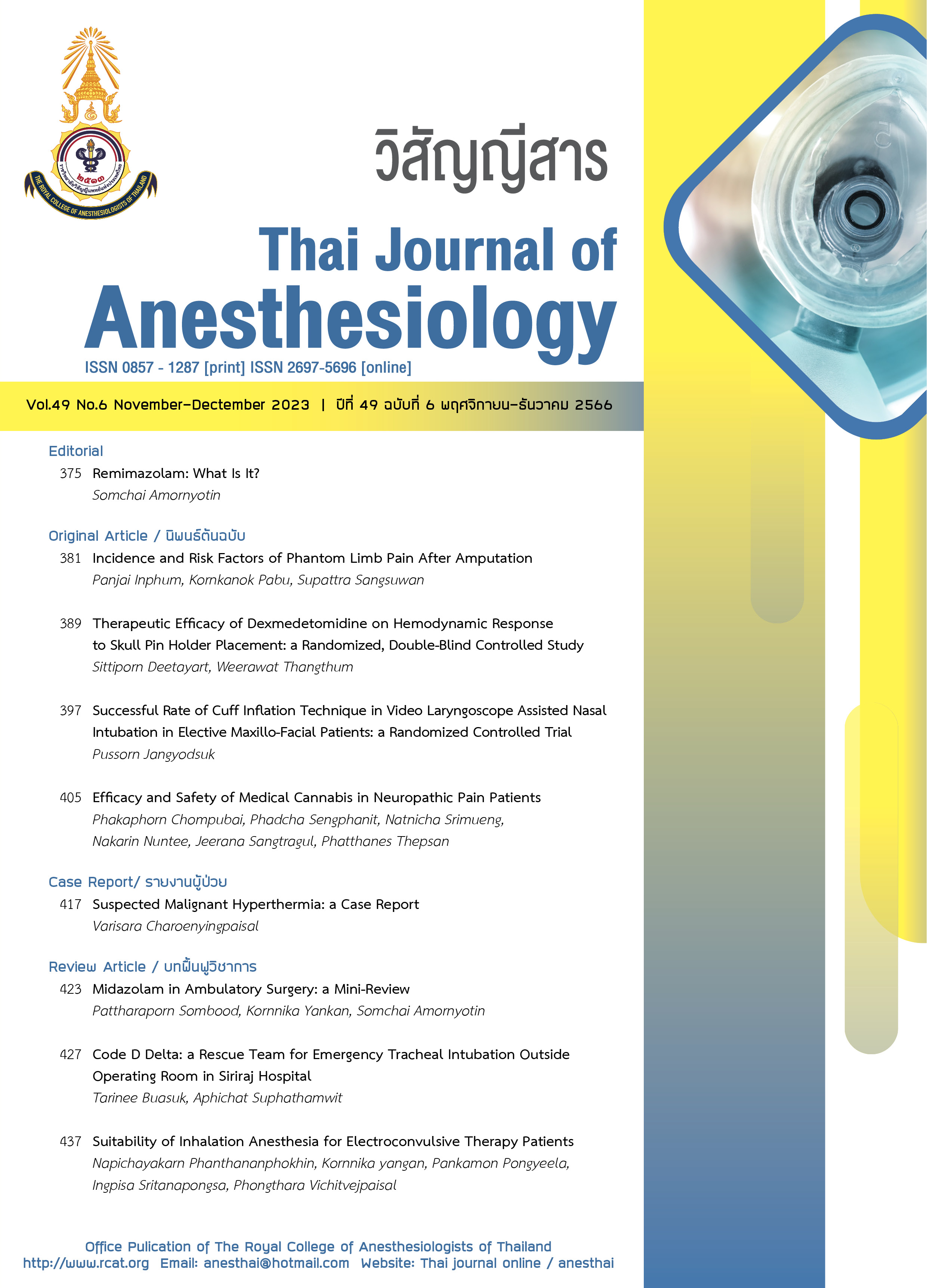Incidence and Risk Factors of Phantom Limb Pain After Amputation
Main Article Content
บทคัดย่อ
Background: Phantom limb pain (PLP) is pain or discomfort in the amputated limb. There isn’t a precise explanation that identifies the risk factors for this pain. The purpose of this study is to determine the incidence and risk factors for PLP particularly with regard to anesthetic techniques and pain management. Methods: This study was a retrospective descriptive study. Medical and anesthetic records of 240 patients who were scheduled for limb amputation surgery from October 2021 to September 2022 were reviewed. The data collection resulted on the incidence of PLP, risk factors, anesthetic techniques, and postoperative pain management. Results: The findings of this study indicated that 5% of patients who underwent limb amputation experienced PLP. The majority of these patients were emergency cases with ASA class III-V (75.0%). PLP was commonly found in patients who suffered from accidents (75.0%), with 71.4% undergoing leg amputation, and 75.0% reporting pre-amputation pain. Additionally, the data showed that 43.8% of patients underwent general anesthesia, and had moderate to severe pain. Strong opioids, gabapentin, and amitriptyline were used for postoperative analgesia. All patients had pain improvement after the treatment. Conclusion: The incidence of PLP was 5.0% at Khon Kaen Hospital. Most patients experienced PLP due to accidents before the amputation, pre-amputation pain, lower limb amputation, and moderate to severe pain after surgery. Approaches to managing PLP included the use of regional anesthesia, perioperative multimodal analgesia, and preventive analgesia.
Article Details

อนุญาตภายใต้เงื่อนไข Creative Commons Attribution-NonCommercial-NoDerivatives 4.0 International License.
เอกสารอ้างอิง
Cho HS, Kim S, Kim CS, Kim YJ, Lee JH, Leem JG. Effects of different anesthetic techniques on the incidence of phantom limb pain after limb amputation: a population-based retrospective cohort study. Korean J Pain. 2020;33:267-74.
Kawashima N, Mita T, Yoshikawa M. Inter-individual difference in the effect of mirror reflection-induced visual feedback on phantom limb awareness in forearm amputees. PLoS ONE. 2013;8:e69324.
Nardone R, Langthaler PB, Höller Y, et al. Modulation of non-painful phantom sensation in subjects with spinal cord injury by means of rTMS. Brain Res Bull. 2015;118:82-6.
Wilkins KL, McGrath PJ, Finley GA, Katz J. Prospective diary study of nonpainful and painful phantom sensations in a preselected sample of child and adolescent amputees reporting phantom limbs. Clin J Pain. 2004;20:293-301.
Limakatso K, Bedwell GJ, Madden VJ, Parker R. The prevalence and risk factors for phantom limb pain in people with amputations: a systematic review and meta-analysis. PLoS ONE. 2020;15:e0240431.
Erlenwein, J, Diers M, Ernst J, Schulz F, Petzke F. Clinical updates on phantom limb pain. Pain Rep. 2021;15:e888.
Montoya P, Larbig W, Grulke N, Flor H, Taub E, Birbaumer N. The relationship of phantom limb pain to other phantom limb phenomena in upper extremity amputees. Pain. 1997;72:87-93.
Kooijman CM, Dijkstra PU, Geertzen JHB, Elzinga A, van der Schans CP. Phantom pain and phantom sensations in upper limb amputees: an epidemiological study. Pain. 2000;87:33-41.
Bosmans JC, Geertzen JHB, Post WJ, van der Schans CP, Dijkstra PU. Factors associated with phantom limb pain: a 31/2-year prospective study. Clin Rehabil. 2010;24:444-53.
Hanley MA, Jensen MP, Smith DG, Ehde DM, Edwards WT, Robinson LR. Preamputation pain and acute pain predict chronic pain after lower extremity amputation. J Pain. 2007;8:102-9.
Schley MT, Wilms P, Toepfner S, et al. Painful and nonpainful phantom and stump sensations in acute traumatic amputees. J Trauma. 2008;65:858-64.
von Plato H, Kontinen V, Hamunen K. Efficacy and safety of epidural, continuous perineural infusion and adjuvant analgesics for acute postoperative pain after major limb amputation-a systematic review. Scand J Pain. 2018;18:3-17.
Flor H, Nikolajsen L, Jensen TS. Phantom limb pain: a case of maladaptive CNS plasticity? Nat Rev Neurosci. 2006;7:873-81.
Dickinson BD, Head CA, Gitlow S, Osbahr AJ. Maldynia: pathophysiology and management of neuropathic and mal-adaptive pain-a report of the AMA council on science and public health. Pain Med. 2010;11:1635-53.
Baron R. Mechanisms of disease: neuropathic pain-a clinical perspective. Nat Clin Pract Neurol. 2006;2:95-106.
Yin Y, Zhang L, Xiao H, et al. The pre-amputation and the postoperative deafferentation are the risk factors of phantom limb pain: a clinical survey in a sample of Chinese population. BMC Anesthesiol. 2017;17:69.
Schley MT, Wilms P, Toepfner S, et al. Painful and nonpainful phantom and stump sensations in acute traumatic amputees. J Trauma. 2008;65:858-64.
Jong RD, Shysh AJ. Development of a multimodal analgesia protocol for perioperative acute pain management for lower limb amputation. Pain Res Manag. 2018;2018:5237040.
McCormick Z, Chang-Chien G, Marshell B, Huang M, Harden RN. Phantom limb pain: a systematic neuroanatomical-based review of pharmacologic treatment. Pain Med. 2014;15:292-305.
Fang J, Lian YH, Xie KJ, Cai S. Pharmacological interventions for phantom limb pain. Chin Med J. 2013;126:542-9.
Alviar MJ, Hale T, Dungca M. Pharmacological interventions for treating phantom limb pain. Cochrane Database Syst Rev. 2016;10:CD006380.


